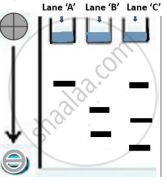Advertisements
Advertisements
प्रश्न
If Meselson and Stahl's experiment is continued for four generations in bacteria, the ratio of `15_N/15_N:15_N/14_N:14_N/14_N` containing DNA in the fourth generation would be ______.
विकल्प
0 : 1 : 7
0 : 1 : 3
1 : 4 : 0
1 : 1 : 0
उत्तर
If Meselson and Stahl's experiment is continued for four generations in bacteria, the ratio of `15_N/15_N:15_N/14_N:14_N/14_N` containing DNA in the fourth generation would be 0 : 1 : 7.
APPEARS IN
संबंधित प्रश्न
Describe Meselson and Stahl’s experiment that was carried in 1958 on E.Coli. Write the conclusion they arrived at after the experiment.
Name two enzymes involved in the process of DNA replication along with their properties.
Draw a diagrammatic sketch of a portion of DNA segment to support your answer.
Why is it not possible for an alien DNA to become part of a chromosome anywhere along its length and replicate normally?
Which of the following phenomena was experimentally proved by Meselson and Stahl?
DNA replication takes place at ______ phase of the cell.
If Meselson and Stahl's experiment is continued for sixth generations in bacteria, the ratio of Heavy strands 15N/15N: Hybrid15N/14N: light 14N/14N containing DNA in the sixth generation would be ______
In which type of DNA replication of the two newly formed molecules, one is purely a new one and the other one is old?
Discuss the significance of heavy isotope of nitrogen in the Meselson and Stahl’s experiment.
The DNA molecules of the same size were extracted from E. coli and Plasmodium vivax. It was discovered that both the DNA molecules had one target site each for the restriction enzyme Hind II. After being digested with Hind II, the DNA fragments were subjected to gel electrophoresis.
With reference to the diagram given below, identify the lanes that represent the DNA fragments of E. coli and Plasmodium vivax respectively. Justify your answer with a reason for each.

